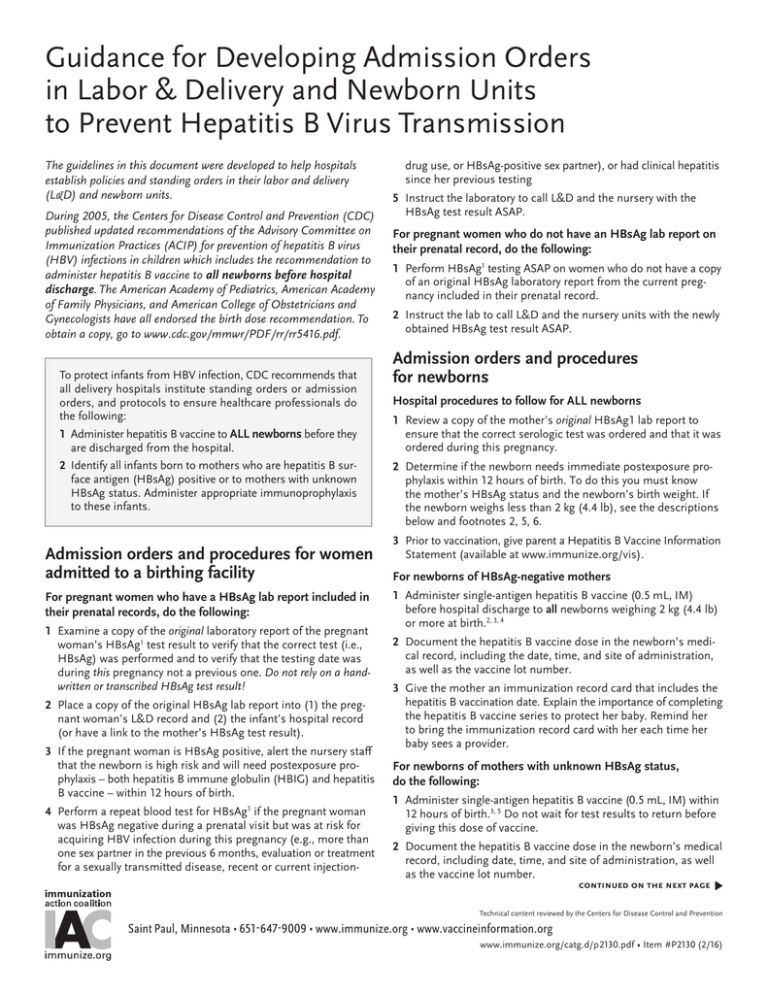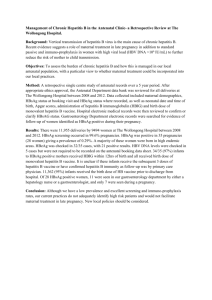Guidance for Developing Admission Orders to Prevent Hepatitis B Virus Transmission
advertisement

Guidance for Developing Admission Orders in Labor & Delivery and Newborn Units to Prevent Hepatitis B Virus Transmission The guidelines in this document were developed to help hospitals establish policies and standing orders in their labor and delivery (L&D) and newborn units. During 2005, the Centers for Disease Control and Prevention (CDC) published updated recommendations of the Advisory Committee on Immunization Practices (ACIP) for prevention of hepatitis B virus (HBV) infections in children which includes the recommendation to administer hepatitis B vaccine to all newborns before hospital discharge. The American Academy of Pediatrics, American Academy of Family Physicians, and American College of Obstetricians and Gynecologists have all endorsed the birth dose recommendation. To obtain a copy, go to www.cdc.gov/mmwr/PDF/rr/rr5416.pdf. To protect infants from HBV infection, CDC recommends that all delivery hospitals institute standing orders or admission orders, and protocols to ensure healthcare professionals do the following: 1Administer hepatitis B vaccine to ALL newborns before they are discharged from the hospital. 2Identify all infants born to mothers who are hepatitis B surface antigen (HBsAg) positive or to mothers with unknown HBsAg status. Administer appropriate immunoprophylaxis to these infants. Admission orders and procedures for women admitted to a birthing facility For pregnant women who have a HBsAg lab report included in their prenatal records, do the following: 1 Examine a copy of the original laboratory report of the pregnant woman’s HBsAg1 test result to verify that the correct test (i.e., HBsAg) was performed and to verify that the testing date was during this pregnancy not a previous one. Do not rely on a handwritten or transcribed HBsAg test result! 2 Place a copy of the original HBsAg lab report into (1) the pregnant woman’s L&D record and (2) the infant’s hospital record (or have a link to the mother’s HBsAg test result). 3 If the pregnant woman is HBsAg positive, alert the nursery staff that the newborn is high risk and will need postexposure prophylaxis – both hepatitis B immune globulin (HBIG) and hepatitis B vaccine – within 12 hours of birth. 4 Perform a repeat blood test for HBsAg1 if the pregnant woman was HBsAg negative during a prenatal visit but was at risk for acquiring HBV infection during this pregnancy (e.g., more than one sex partner in the previous 6 months, evaluation or treatment for a sexually transmitted disease, recent or current injection- drug use, or HBsAg-positive sex partner), or had clinical hepatitis since her previous testing 5 Instruct the laboratory to call L&D and the nursery with the HBsAg test result ASAP. For pregnant women who do not have an HBsAg lab report on their prenatal record, do the following: 1 Perform HBsAg1 testing ASAP on women who do not have a copy of an original HBsAg laboratory report from the current pregnancy included in their prenatal record. 2 Instruct the lab to call L&D and the nursery units with the newly obtained HBsAg test result ASAP. Admission orders and procedures for newborns Hospital procedures to follow for ALL newborns 1Review a copy of the mother’s original HBsAg1 lab report to ensure that the correct serologic test was ordered and that it was ordered during this pregnancy. 2Determine if the newborn needs immediate postexposure prophylaxis within 12 hours of birth. To do this you must know the mother’s HBsAg status and the newborn’s birth weight. If the newborn weighs less than 2 kg (4.4 lb), see the descriptions below and footnotes 2, 5, 6. 3Prior to vaccination, give parent a Hepatitis B Vaccine Information Statement (available at www.immunize.org/vis). For newborns of HBsAg-negative mothers 1Administer single-antigen hepatitis B vaccine (0.5 mL, IM) before hospital discharge to all newborns weighing 2 kg (4.4 lb) or more at birth.2, 3, 4 2Document the hepatitis B vaccine dose in the newborn’s medical record, including the date, time, and site of administration, as well as the vaccine lot number. 3Give the mother an immunization record card that includes the hepatitis B vaccination date. Explain the importance of completing the hepatitis B vaccine series to protect her baby. Remind her to bring the immunization record card with her each time her baby sees a provider. For newborns of mothers with unknown HBsAg status, do the following: 1Administer single-antigen hepatitis B vaccine (0.5 mL, IM) within 12 hours of birth.3, 5 Do not wait for test results to return before giving this dose of vaccine. 2Document the hepatitis B vaccine dose in the newborn’s medical record, including date, time, and site of administration, as well as the vaccine lot number. continued on the next page � Technical content reviewed by the Centers for Disease Control and Prevention Saint Paul, Minnesota • 651- 647- 9009 • www.immunize.org • www.vaccineinformation.org www.immunize.org/catg.d/p2130.pdf • Item #P2130 (2/16) Guidance for Developing Admission Orders in Labor & Delivery and Newborn Units (continued) 3Give the mother an immunization record card that includes the hepatitis B vaccination date. Explain the importance of completing the hepatitis B vaccine series to protect her baby. Remind her to bring the immunization record card with her each time her baby sees a provider. 4Confirm that the laboratory has received blood for the mother’s HBsAg1 test. 5Verify when the mother’s HBsAg result will be available and that it will be reported to L&D and the newborn unit ASAP. 6If the nursery does not receive the report of the mother’s HBsAg test at the expected time, call the laboratory for the result. 7If the laboratory test indicates the mother’s HBsAg1 test result is positive, do the following: aAdminister HBIG (0.5 mL, IM) to the newborn ASAP. (Hepatitis B vaccine should have been given within 12 hours of birth.) bDocument the HBIG dose in the newborn’s medical record. There is little benefit in administering HBIG to the newborn if more than 7 days have elapsed since birth. cAlert the mother’s and newborn’s physician(s) of the test result. dFollow the instructions below “For newborns of HBsAg-positive mothers,” steps 3–7. 8If the newborn must be discharged before the mother’s HBsAg result is known: aDocument the parents’ contact information (e.g., addresses, telephone numbers, emergency contacts) in case further treatment is needed for the infant. bObtain the name, address, and phone number of the mother’s and the newborn’s healthcare providers. cNotify the mother’s and newborn’s healthcare providers that the mother’s HBsAg test result is pending. page 2 of 2 7 Provide advice to the mother. Tell her the following: aThat she may breast-feed her infant upon delivery, even before hepatitis B vaccine and HBIG are given; bThat it is critically important for the protection of her baby’s health that the baby receives the full hepatitis B vaccine series on the recommended schedule; cThat blood tests (HBsAg and antibody to hepatitis B surface antigen [anti-HBs]) need to be drawn from the baby 1–2 months after completion of the 3- or 4-dose hepatitis B vaccine series and also no earlier than 9–12 months of age to determine if the child developed a protective immune response to vaccination or needs additional management7; dAbout modes of HBV transmission and the need for testing and vaccination of susceptible household, sexual, and needlesharing contacts; eThat she needs to have a medical evaluation for chronic hepatitis B, including an assessment of whether she is a candidate for antiviral treatment. footnotes 1.Be sure the correct test for HBsAg (hepatitis B surface antigen) was/is ordered. The HBsAg test should not be confused with other hepatitis B serologic tests, including antibody to HBsAg (anti-HBs or HBsAb) and antibody to hepatitis B core antigen (anti-HBc or HBcAb). 2.Infants weighing less than 2 kg (4.4 lb) at birth and whose mothers are documented to be HBsAg negative should receive the first dose of vaccine 1 month after birth or at hospital discharge, whichever comes first. The mother’s HBsAg test result must be part of the infant’s medical record. 3.Federal law requires that you give parents a Hepatitis B Vaccine Information Statement (VIS) before vaccine administration. To obtain a VIS, download it from the IAC website at www.immunize.org/vis. 1Administer HBIG (0.5 mL, IM) and single-antigen hepatitis B vaccine3, 6 (0.5 mL, IM) at separate injection sites within 12 hours of birth. 4.According to the CDC recommendations, exceptions to administering the birth dose of hepatitis B vaccine are allowed on a case-by-case basis and only in rare circumstances. If the hepatitis B vaccine birth dose is not administered, a copy of the mother’s negative HBsAg test result from the current pregnancy must be placed in the infant’s medical record and the attending physician must write a specific order directing staff not to administer the birth dose in the hospital. Infants who do not receive the first dose of hepatitis B vaccine before hospital discharge should receive the first dose no later than age 2 months. 2Document the hepatitis B vaccine and HBIG dose in the newborn’s medical record, including the date, time, and site of administration, as well as the vaccine lot number. 5.An infant weighing less than 2 kg (4.4 lb) whose mother’s HBsAg status is unknown should receive HBIG and hepatitis B vaccine within 12 hours of birth. Do not count the hepatitis B vaccine dose as the first dose in the vaccine series. Reinitiate the full hepatitis B vaccine series at age 1–2 months. 3Give the mother an immunization record card that includes the hepatitis B vaccination and HBIG dates. Explain the importance of completing the hepatitis B vaccine series to protect her baby. Remind her to bring the card with her each time her baby sees a provider. 6.An infant weighing less than 2 kg (4.4 lb) whose mother is HBsAg positive should receive the first dose of hepatitis B vaccine and HBIG within 12 hours of birth. Do not count the hepatitis B vaccine dose as the first dose in the vaccine series. Reinitiate the full hepatitis B vaccine series at age 1–2 months. For newborns of HBsAg-positive mothers 4Notify the local or state health department of the infant’s birth and the date and time of administration of HBIG and hepatitis B vaccine doses. 5Obtain the name, address, and phone number of the newborn’s primary care provider. 6Notify the provider of the newborn’s birth, the date and time of HBIG and hepatitis B vaccine doses administered, and the importance of additional on-time vaccination as well as postvaccination testing of the infant for both HBsAg and antibody to HBsAg (anti-HBs) after completion of the hepatitis B vaccine series to assess the hepatitis B status of the infant following vaccination. 7.The optimal timing for serologic testing to detect a vaccine response generally is 1–2 months after the final dose of the HepB vaccine series. Results of tests for HBsAg can be transiently positive for 1–18 days after vaccination. Serologic testing should be performed no earlier than age 9 months to avoid detection of passive anti-HBs from hepatitis B immune globulin administered at birth and to maximize the likelihood of detecting late HBV infection (see “Update: Shortened interval for postvaccination serologic testing of infants born to hepatitis B-infected mothers,” MMWR, 2015;64: 1118–20). •F or “Sample Text for Developing Admission Orders in Newborn Units for the Hepatitis B Birth Dose,” visit www.immunize.org/catg.d/p2131.pdf. Immunization Action Coalition • Saint Paul, Minnesota • 651- 647- 9009 • www.immunize.org • www.vaccineinformation.org www.immunize.org/catg.d/p2130.pdf • Item #P2130 (2/16)

